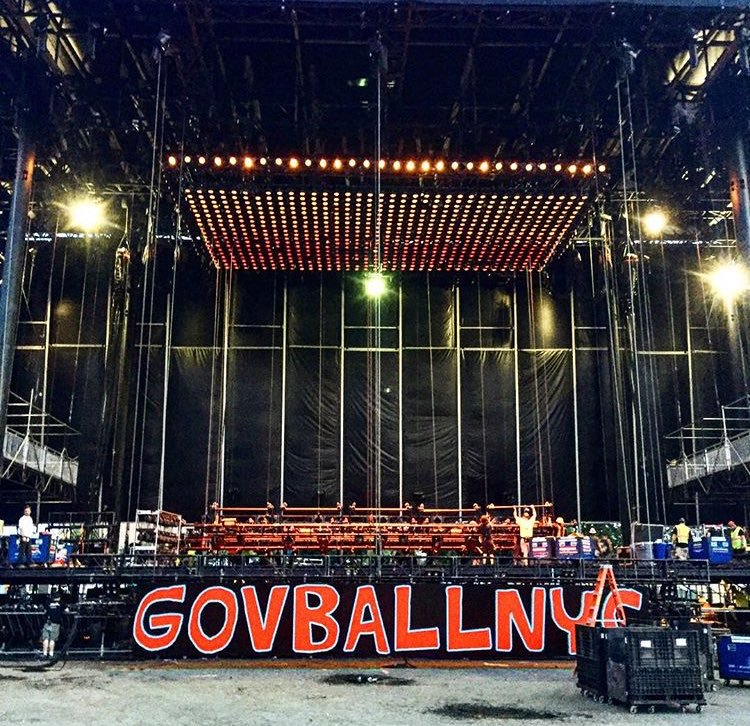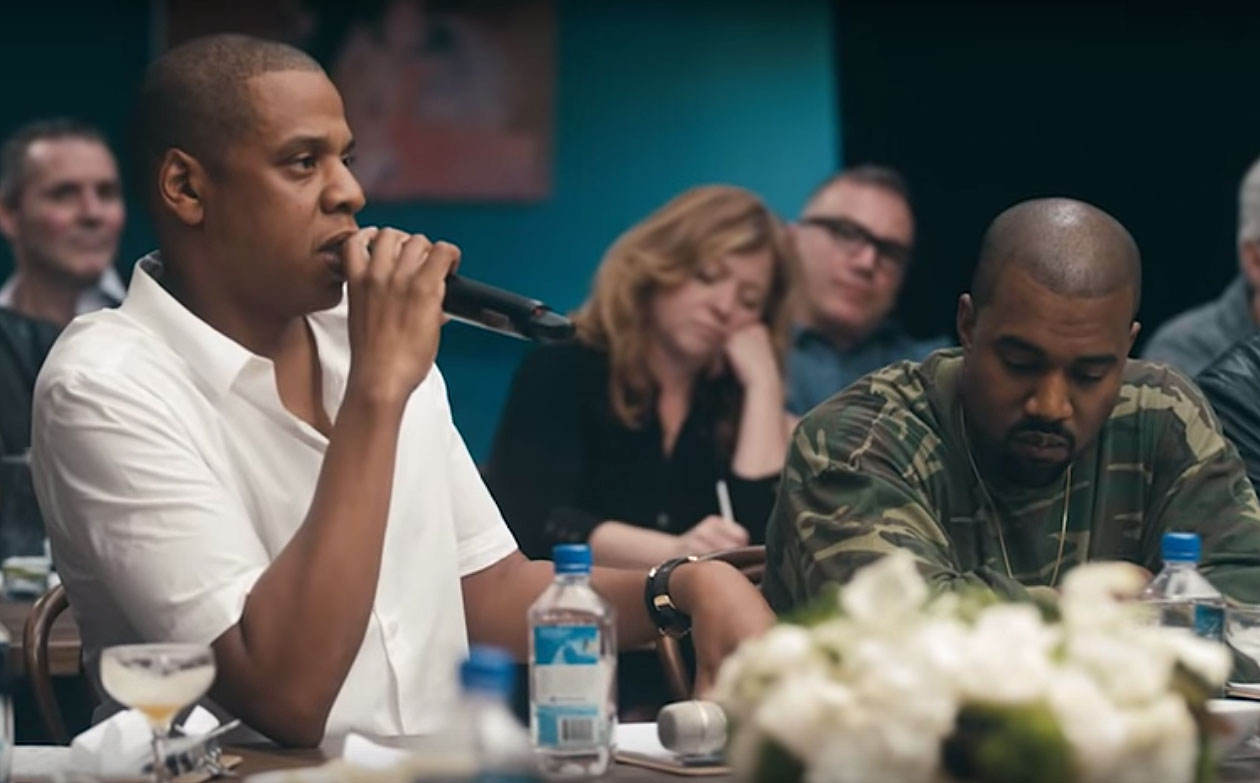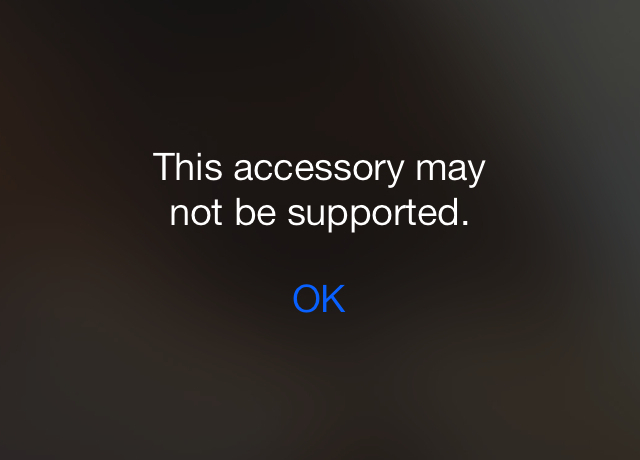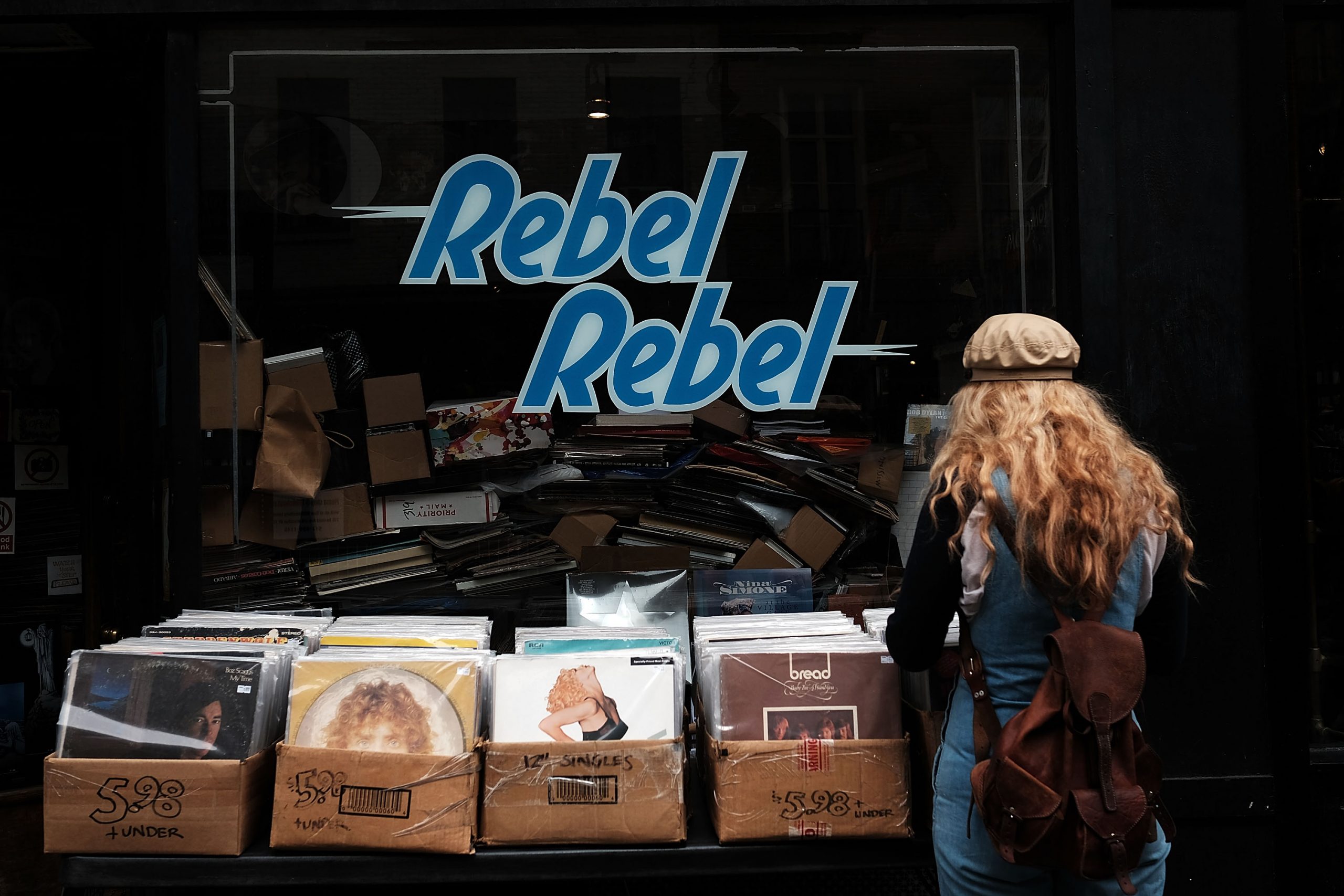Back in January, I wrote this story for Stereogum about an unusually public clash between two music festivals. Both were happening in New York City, both would go down in summer 2016, both looked pretty much the same from a distance, and both, it seemed, could not survive. Not together. There could be one. But not both.
In one corner was the newly announced Panorama, whose inaugural installment was set to be staged by the world's second-biggest concert-production company, AEG. In the other corner: the half-decade-old Governors Ball, which was run by the local independent operation Founders Entertainment, a team of four people working out of a single office in Manhattan.
The tiny Founders team didn't stand a chance against the gigantic AEG, but that didn't stop them. They fought like motherfuckers and moved like ninjas and strategized like chess masters and somehow ... they won. Or, at least, they managed to stave off AEG's advances in a way that felt like a victory. They had forced Panorama to abandon its intended plans and adopt entirely less-profitable new ones. They had lived to fight another day.
On its face, this was a relatively minor story about a niche industry in an individual market, but I didn't (and still don't) believe it could be discounted or dismissed as such. I saw this as a gigantic story. What we were witnessing in New York City would resonate around the world. Different versions of the same events were playing out everywhere. In music, yes, but not just music: in retail, in real estate, in tech, in food, whatever. It was a universal struggle writ small -- a human story and a timeless story. It was the Battle Of Thermopylae and The Karate Kid and Moneyball and fucking Hamilton. It was a mom-and-pop shop holding the line against a corporate behemoth. It was a band of insurgents fighting off the establishment. It was a story about building a sustainable small business in an economy whose infrastructure has been weakened by rampant deregulation and ineffective antitrust laws. It was a story about the American Dream in a fundamentally fucked-up America.
It was a story that felt meaningful and important and kind of amazing -- to me, at least -- and I tried to tell it in a way that would reflect all this, because I wanted other people to feel something, too.
Two months later, the guys who owned Founders guys sold a majority stake of their business to the world's biggest concert-production company, Live Nation.
And just like that, the story I wanted to tell was over.
But that didn't mean the story was over. "Goliath vs. Goliath" might not make for a great movie, but you can't just ignore that shit when it's playing out in real life, especially when it's all blowing up in your own backyard. So I decided I'd return to the subject once both festivals had concluded for the summer, to see how they'd gone, to see where we stood.
It's been a minute, and a whole bunch of stuff has happened between then and now -- including GovBall in early June and Panorama just last weekend, but that's barely the tip of the iceberg -- and finally, here we are.
The story has gotten much bigger. We've got a lot to talk about.
AEG's initial proposal for Panorama would have set the event in mid-June, just two weeks after GovBall, and staged the event in Queens' spacious Flushing Meadows Corona Park, a scenic parcel of property much more accessible than GovBall's longtime home -- the relatively inconvenient Randall's Island.
Founders' victory had been in forcing AEG to move both the date and location of Panorama: from pleasant mid-June to horrible late-July; from Flushing Meadows to Randall's Island. Stripped of these advantages, Panorama was no longer an intriguing alternative to GovBall -- it was just a shittier version of the same thing (plus or minus a couple points depending on how you felt about the headlining acts).
And with that win in the books and the backing of Live Nation's resources, Governors Ball found itself equipped with countless advantages over its rival. It needed only not to be a disaster in order to score a decisive victory.
But ... it was a disaster.
You might remember some or all of this madness, but just in case you don't, let's relive it together.
First, an unrelated shooting at an unaffiliated event prompted the cancellation of numerous "Governors Ball After Dark" shows at Live Nation venues across the city.
Yeah woulda been a real nightmare being forced to watch Kanye in this weather. pic.twitter.com/v4E6fKyMVv
— Michael Nelson (@nelsonicboom) June 6, 2016
Needless to say, Founders and Live Nation had to issue partial refunds to the tens of thousands of people who had purchased tickets to GovBall, which, combined with all the other accumulated losses, couldn't help but hurt the festival's bottom line, and did nothing to maintain the established goodwill.
This ungodly stack of losses left AEG in prime position to capitalize. Panorama had to only not be a disaster in order to emerge as the clear victor in the 2016 installment of the New York City Festival Wars.
Last weekend, finally, Panorama arrived.
You know where this is going, right?
If Panorama's flaws weren't as well-publicized as GovBall's, that's mostly because Panorama wasn't able to generate enough publicity for those flaws to warrant coverage. Panorama landed just in time for New York City to be enveloped in an unusually punishing weather phenomenon called a heat dome. A HEAT DOME. The National Weather Service issued a heat advisory and an air quality alert.
Here's a look at YOUR 10 Day Extended Forecast! pic.twitter.com/zQWJBRMXKl
— Storm Team 4 NY (@StormTeam4NY) July 19, 2016
The weekend would be bookended by thunderstorms, and while Saturday and Sunday would be dry enough to stage shows without interruption, those days would also be hot enough to fry computers. This is not a figure of speech. GQ ran a feature titled "How The Artists At The Panorama Festival Stay Cool During The Heat Wave," and TWO of the six artists interviewed expressed concern regarding their laptops melting.
(Incidentally, climate change looks to be a major factor affecting the music festival market in the coming years.)
Moreover, Panorama appeared to be a dud at the box office. According to The Los Angeles Times, "crowd numbers were admittedly lower than organizers had hoped for." Reviews of Panorama paid heed to the numerous positives -- the air-conditioned bathrooms came up a lot -- but none of them failed to mention the excruciating heat or the sparse crowds. Many of them simply compared GovBall to Panorama, and none effectively or decisively answered the primary question posed by the arrival of Panorama onto a scene already occupied by GovBall:
"Is there room in the city for two big fests?"
After the pair of disasters we saw this summer, the better question might be: "Is there room in the city for even one big fest?"
That's moot for the moment, though, because last month, Live Nation and Founders added a third.
The newest addition to the city's calendar will bring Kanye back to New York City to make up for his rained-out set at Governors Ball. This time he'll be joined by the Weeknd, Chance The Rapper, the 1975, Grimes, and a few dozen others. The event is called the Meadows Music And Arts Festival, and that name derives from -- what else? -- Flushing Meadows Corona Park, the very same piece of real estate on which AEG hoped to stage Panorama.
It should be noted that Flushing Meadows is a city-run park, and as is the case with all such properties, the numerous layers of bureaucracy and high degrees of community involvement make staging any for-profit event on its grounds just about impossible. But Founders, it seemed, had achieved the impossible! As the company's Tom Russell said in a statement:
Launching the Meadows Festival in Queens this fall with an incredible lineup of music, art, food and culture is a dream come true. As a native New Yorker I grew up in awe of the innovative spirit surrounding Flushing Meadows Corona Park. With this event we can shine a spotlight once again on this iconic neighborhood...
The implication here is that this is happening at Flushing Meadows Corona Park, right? You've got the name, then that statement from Russell, and then, there's the Meadows' logo, an illustration of Flushing Meadows' most famous structure, the Unisphere, a 350-ton, 120-foot-diameter globe "located at the center of the radial pathways in the northern half of Flushing Meadows-Corona Park," an artifact from the New York World's Fair of 1964-65 and one of the outer boroughs' more enduring landmarks.

That is the implication, right?
So OK, yes, technically speaking the Meadows is being held in a part of Flushing Meadows-Corona Park ... just not the part that houses the Unisphere. According to the press release announcing the event, the Meadows will be held "at the Citi Field complex in Flushing Meadows Corona Park in the storied borough of Queens, New York."
The Citi Field complex. Do you know what that means? Citi Field is the 45,000-capacity stadium in which the New York Mets play their home games, and when the Mets aren't around, it hosts concerts starring the likes of Beyoncé and Foo Fighters. But staging an event in the Citi Field complex is not really the same as being in "the park." It's not even in the ballpark. It's THE PARKING LOT. Literally. That's why there was no government interference. As DNAInfo notes:
The parking lot of Citi Field isn't under the Parks Department's jurisdiction, although it is technically part of the expansive park.
So Founders and Live Nation did an end run around the city (which the city wasn't all that happy about) and arranged to hold a two-day festival on a few acres of asphalt right next to both (A) the Grand Central Parkway, one of the city's great traffic nightmares; and (B) LaGuardia airport, where you've got low-flying aircraft coming and going overhead at pretty regular intervals. That's totally fine, of course, and by no means unprecedented: The EDM fest Electric Daisy Carnival has been held in that very same parking lot several times. It seems a little disingenuous, though, to intimate that festival goers will be spending their days here:
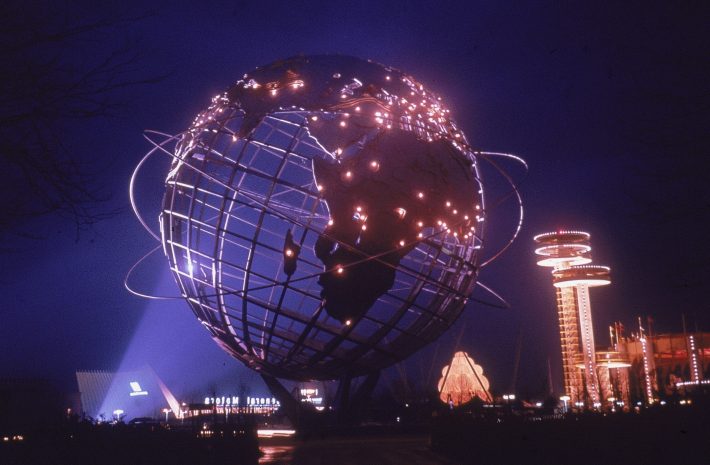
Because they won't. They'll be kinda-sorta next door to that, but that's not where they'll be. Instead, they'll arrive at the park, ready to spend 11 or 12 hours in an expansive verdant field, only to actually be redirected ... here:
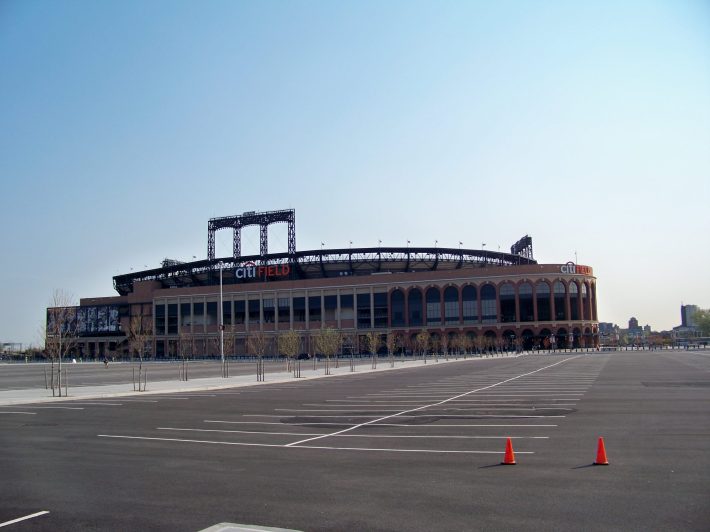
There are other semi-substantial inconveniences being glossed over, too. First off, the Meadows will be held on Saturday 10/1 and Sunday 10/2, with music ending at 11PM both nights. But 10/2 is also the first night of Rosh Hashanah, which begins at sundown 10/2, so anybody observing that Jewish High Holy Day will be forced to leave long before Kanye's set, before Chance The Rapper's set ... basically, before several of the most exciting sets of the whole festival. Also, the Meadows conflicts with the seven-year-old Maker Faire, a science- and technology-themed event aimed at children that brings some 95,000 people to Flushing Meadows Corona Park, all of whom have, in the past, been allowed to park their vehicles in -- wouldn't ya know it? -- the now-occupied Citi Field parking lot. Either one of these events alone would inevitably create a traffic nightmare on the always-congested-anyway stretch of the Grand Central surrounding LaGuardia, but both occurring on the same weekend with neither offering anyplace to park?
"It is astounding that Live Nation and Founders Entertainment are proceeding with their plans for [the Meadows]," said Dan Wempa, the vice president of external affairs for the New York Hall Of Science, in a statement issued on behalf of Maker Faire. "Worse, they are proceeding with a complete lack of transparency or community engagement about how they intend to assure that their event doesn’t negatively impact the park. By bringing another 30,000 to 50,000 people per day into the neighborhood, this poorly planned mega-concert will undermine what we have done over the past seven years to address community concerns about traffic, safety, and parking."
So that's gonna be an issue. Finally, there's the question of the Meadows' headliner -- Kanye West -- who is indeed one of the few artists in the world big enough to anchor an event such as this (and one of my faves!), but who wouldn't even have been available had Governors Ball not been a last-minute washout. After all, it's not as though the Meadows had been built around the Kanye rain date; the festival had been in play for weeks prior to GovBall.
"We were lucky for [Kanye's people] to consider it," said Founders' Russell in an interview with Inc. regarding the company's decision to book Kanye for the Meadows. "We were lucky to even have that conversation."
But that stroke of luck was precipitated by some very bad luck. So what was Plan A? Was there a Plan A?
It doesn't really matter now, of course, and none of these issues, alone or combined, are dealbreakers anyway; they're just evidence of questionable judgment and poor planning. They show a clear absence of the savviness and stability on which the Founders team built their reputation. (That said, pretty much everything about the Meadows feels like a humongous subtweet if not an outright middle finger aimed at AEG, and I'll admit that is a very punk-rock move, and kinda hilarious, and totally in line with the Founders brand, although I can't imagine more than a few dozen people getting the joke.) GovBall didn't just drop out of the sky, prefabricated and fully formed, as a three-day event able to sell out every year. It started small, evolved slowly, and grew in conjunction with the community to be something much bigger. GovBall was smart, sustainable, cognizant of the market's idiosyncrasies and demands.
Panorama, on the other hand ... now that just dropped out of the sky. And it landed like a fucking brick.
The litany of inexplicable and inadvisable choices built into the Meadows indicate a similar approach: They suggest the event was rushed to market not because the city was clamoring for a third major music festival, but because Live Nation saw an opportunity to make a land grab, to make it harder for AEG to establish a festival foothold in New York City.
Over the past several years, countless articles have been published positing some version of the question, "Are music festivals a bubble waiting to burst?"
But here's the thing: The wait is over. That bubble has already imploded. It's gone.
Last year was pretty bad for for festivals, and this year has been even worse. Per The Tennessean, ticket sales for Nashville's Bonnaroo "fell precipitously this year to an all-time low of 45,537 ... The festival sold 28,156 fewer tickets in 2016 compared to [2015]." Washington State's Sasquatch! fared even worse. Wrote The Oregonian: "Only '11,000 ticket holders' showed up to this year's Sasquatch! music festival over the Memorial Day weekend" -- down more than 50 percent from the event's usual 25,000. At this month's Pitchfork Music Festival, "attendance overall was down," according to the Chicago Tribune: "two of the three days were not sold out, according to promoters." In May, England's All Tomorrow's Parties 2016 festival was cancelled, and in June, All Tomorrow's Parties went out of business entirely, offering an apology: "We are very sorry we could not make this work and have tried to survive throughout all our recent losses but we are no longer able to trade and have to accept we cannot go on."
It goes beyond the indie sector, of course. In February of this year, Fox News published a story titled, "Country Music Festivals Shutting Down Left And Right." A month later, Fest300 (a site dedicated to covering "The World's Best Festivals") published a story titled "Why Have So Many Music Festivals Cancelled In 2016?" A month after that, Pitchfork published a story titled "Popping the Drop: A Timeline Of How EDM's Bubble Burst." This past May's New Orleans Jazz Fest was down 35,000 people from last year's total. Last week, America's biggest extreme-metal festival -- Maryland Death Fest -- announced it would be downsizing substantially, citing untenable production costs, and telling customers to "please know that this decision was necessary for MDF to continue for years to come." Earlier this week, Ohio's Buckle Up Festival announced it had been cancelled, just 11 days prior to the event's opening day.
Of course, not every festival is suffering -- Coachella is still doing business and the CMA Music Festival saw attendance increase by 1 percent over the record it set for itself just last year -- but very few festivals even release attendance figures, so it's probably safe to assume that a lot more are suffering.
This past March, Billboard published an excellent analysis titled "Is The Country Festival Business Past Its Peak?" Needless to say, the country market and the indie market aren't identical (e.g., "During the past 10 years, country events have been the biggest growth area in the North American festival sector"), but the same factors affect both, to some degree. I'm just gonna excerpt some lines here, because I think they apply.
• "The biggest factor is oversaturation," says Gil Cunningham, president of Neste Event Marketing, which buys talent for 16 country music festivals. "Most of my festivals are either on par or maybe a little ahead of last year, but they’re definitely not blowing up like they did in the last couple of years."
• "It's greed," says Kenny Chesney's manager Clint Higham, who largely has avoided the festival circuit. "Managers and the agents and the artists have pushed the guarantees, and these festivals are paying for it. We're all guilty of it. The market can only bear so much."
• "The heart of the industry revolves around viable superstar headliner talent to push your ticket sales over the top," says Quint Davis, CEO of Festival Productions Inc. Thus, festival talent buyers either must pay for top-tier talent and raise ticket prices to compensate, or take a pass on those artists.
Literally every single person quoted in that Billboard story is downbeat, bearish, cynical. Every single person ... except this person.
• Live Nation country music president Brian O'Connell, who embarked on a quest to launch 10 festivals in 10 years and has presented six to date -- including Watershed in Washington state, Faster Horses in Michigan and Route 91 Harvest in Las Vegas, but also the canceled FarmBorough and Delaware Junction -- remains optimistic. Even with the two missteps, O’Connell, by far the biggest buyer of country talent in the world, is planning on staging more events. "My views have not changed regarding new festival opportunities," he tells Billboard. "We are still very committed to expanding our portfolio and I am always on the hunt for that magic site, and creating a brand that speaks to people."
Do you know what attrition warfare is? You probably do, but in case you don't: Attrition warfare is "a military strategy in which a belligerent attempts to win a war by wearing down the enemy to the point of collapse through continuous losses in personnel and materiel. The war will usually be won by the side with greater such resources."
It's not just a military strategy, of course, but a business strategy, too. It's the strategy AEG intended to use when it first took on Founders: In that scenario, AEG was the belligerent, and it was engaging Founders in a war of attrition. Founders pulled off a miracle fighting back their enemy this year, but they didn't have the resources to compete in the long run. Had they stayed the course, GovBall would have been a memory by 2018. For months, Founders and AEG had been playing a game of chicken in the press, but the spectacle was like watching a kid on a BMX bike facing off against a crew of construction workers behind the wheel of a bulldozer. By hooking up with Live Nation, that kid found himself inside a tank; no longer the driver, but more crucially, no longer in danger of being squashed. The Founders team talked a good game and spun the Live Nation "partnership" as a carefully considered growth strategy, but from this vantage, it looked like a last-resort move, like they had no other option (unless you consider "extinction" to be an option).
So they chose survival over suicide. It was a smart choice. They still have jobs. They're still here.
Live Nation, meanwhile, has been engaged in a war of attrition with the entire festival industry for years now, and you can see how that's playing out. The company is swallowing everything in its path, and flattening everything that can't be swallowed. Founders weren't the first to sell; in fact, they held out longer than most. In 2014, Live Nation bought Lollapalooza and Austin City Limits. In 2015, Live Nation bought Bonnaroo. For everyone else in America, the country-music market is fucking collapsing -- "greed" and "oversaturation" are no friends to a sustainable economy -- yet Live Nation is "still very committed to expanding [their] portfolio."
Because that's what they do.
And that's what's happening in New York City right now. Live Nation is bleeding AEG the way AEG tried to bleed Founders. And AEG is gonna bleed. Last week, Billboard published Nielsen's 2016 Mid-Year Touring Update, which included, among lots of other data, this:

AEG is a giant, but Live Nation is a colossus. When asked about Panorama's disappointing first-year sales figures, AEG's Paul Tollett countered by saying, "We don't have to sell out. We don't even have to be profitable our first year, or even year two. There are other ways to measure success."
Sure there are, and there are plenty of "other ways" in which Panorama might be considered "successful." But that's not the same as survival. Panorama will hemorrhage money -- those air-conditioned bathrooms don't come cheap -- and by year three, it will be gone. The best it can do is hang tight and hope that GovBall hits into a little bad luck, but can you imagine worse luck than what GovBall faced this year? That shit was all over the local tabloids! It doesn't get much worse than that!
Don't get me wrong here -- nobody's gonna shed a tear for AEG, and nobody should, because AEG is doing the exact same thing as Live Nation, bleeding the fuck out of everyone else on that list, not to mention the ever-shrinking number of independent promoters who couldn't possibly hope to make such a list. And nobody should worry too much about New York City's festival market, because New York City doesn't need a festival market: The reason this city can't support two (or three; or maybe even any) festivals is because this city offers lots and lots of other shit to do, and weekend-long festivals aren't really conducive to experiencing all that other shit.
But like I said, this isn't a local story. It's bigger than that. And it's getting bigger still. It's everywhere. This is a story about a war. And when it's over, there are gonna be casualties. We've already seen plenty. We'll see more.
